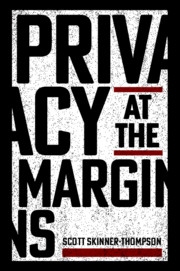Book contents
- Reviews
- Privacy at the Margins
- Privacy at the Margins
- Copyright page
- Dedication
- Contents
- Acknowledgments
- Introduction
- 1 No Privacy in Public = No Privacy for the Precarious
- 2 Performative Privacy in Theory and Practice
- 3 Performative Privacy’s Payoffs
- 4 Containing Corporate and Privatized Surveillance
- 5 Outing Privacy as Anti-Subordination
- 6 Equal Protection Privacy
- Conclusion
- Index
6 - Equal Protection Privacy
Published online by Cambridge University Press: 22 October 2020
- Reviews
- Privacy at the Margins
- Privacy at the Margins
- Copyright page
- Dedication
- Contents
- Acknowledgments
- Introduction
- 1 No Privacy in Public = No Privacy for the Precarious
- 2 Performative Privacy in Theory and Practice
- 3 Performative Privacy’s Payoffs
- 4 Containing Corporate and Privatized Surveillance
- 5 Outing Privacy as Anti-Subordination
- 6 Equal Protection Privacy
- Conclusion
- Index
Summary
If a right exists, bedrock principles of American law generally demand that the right be equally available to all. So unassailable is this tenet that the US Supreme Court etched the phrase, “Equal Justice Under Law,” on the front of the court building in the 1930s. A plaintiff who is black should have the same substantive law applied to their claim as a plaintiff who is white, with similar results for similar claims.1 And although concrete evidence of systematic, unequal judicial results is sometimes hard to uncover, it is widely acknowledged that in many contexts the law does not, in fact, operate with an even hand.2 The white plaintiff prevails where the black plaintiff fails. Can equality, as a principle of American law, become more than hortatory? How can the law be adjusted to operate more equally, and how can those adjustments be doctrinally justified and grounded? This chapter seeks to answer these questions in a particular legal context – the tort of public disclosure of private facts – and to draw lessons from those results for privacy tort reform and the constitutionalization of tort law more broadly.
- Type
- Chapter
- Information
- Privacy at the Margins , pp. 180 - 214Publisher: Cambridge University PressPrint publication year: 2020

